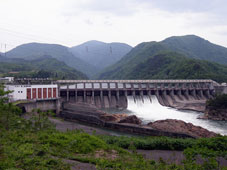Global boom in hydropower expected this decade

Hydro electric power station. Photo: Yonezawa-Shi, Yamagata, Japan
A new database has been developed to support decision making on sustainable modes of electricity production. It is presented today at the international congress Global Challenges: Achieving Sustainability hosted by the University of Copenhagen.
The intensified demand for electricity from renewable sources has kick-started the hydropower development into a new era: Following a period of a flattening trend, an unprecedented number of dams for electricity production is currently under construction or planned worldwide. However, the boom occurs primarily in developing countries and emerging economies in South America, Southeast Asia and Africa, that also hold some of the world’s most important sites for freshwater biodiversity.
“Hydropower is an integrated part of transitioning to renewable energy and currently the largest contributor of renewable electricity. However, it is vital that hydropower dams do not create a new problem for the biodiversity in the world’s freshwater systems, due to fragmentation and the expected changes in the flow and sediment regime.
That is why we have compiled available data on future expected hydropower dams – to form a key foundation for evaluating where and how to build the dams and how to operate them sustainably”, says Prof. Dr. Christiane Zarfl (now Universität Tübingen) who, together with her colleagues, performed the study at the Leibniz-Institute of Freshwater Ecology and Inland Fisheries (IGB) in Berlin. She is presenting the database today at the congress Global Challenges: Achieving Sustainability.
Renewables account for 20 percent of the global electricity production today, with hydropower contributing 80 percent of the total share. An expected 3700 major dams may more than double the total electricity capacity of hydropower to 1,700 GW within the next two decades.
Given that all planned dams are realized, China will remain the global leader in hydropower dam construction although their share of total future global hydropower production will decline from currently 31 to 25 percent, due to increases in other parts of the world.
The Amazon and La Plata basins in Brazil will have the largest total number of new dams in South America, whereas the Ganges-Brahmaputra basin (mainly India and Nepal) and the Yangtze basin in China will face the highest dam construction in Asia.
“When building new dams, it is important to follow a systematic management approach that considers the ecological, social, and economic consequences of multiple dams within a river basin”, says Prof. Dr. Klement Tockner, head of IGB, who is leading the Institute´s research activities on sustainable hydropower development.
“We expect to launch the database in BioFresh, the platform for global freshwater biodiversity (www.freshwaterbiodiversity.eu) and hope to see our results as a valuable reference basis for scientists and decision makers in supporting sustainable hydropower development”, says Prof. Dr. Christiane Zarfl.
The full study will be published in the renowned international journal Aquatic Sciences: Research across Boundaries.
Reference: Zarfl C, Lumsdon AE, Berlekamp J, Tydecks L, Tockner K, (in press) A global boom in hydropower dam construction. Aquatic Sciences.
Contact
Prof. Dr. Christiane Zarfl,
Center for Applied Geoscience, Eberhard Karls Universität Tübingen & Leibniz-Institute of Freshwater Ecology and Inland Fisheries, IGB, Berlin
E-mail: christiane.zarfl@uni-tuebingen.de
Communications officer
Elisabeth Wulffeld
University of Copenhagen
Mobile: +45 21179140
Email: elisabethw@snm.ku.dk
Media Contact
All latest news from the category: Power and Electrical Engineering
This topic covers issues related to energy generation, conversion, transportation and consumption and how the industry is addressing the challenge of energy efficiency in general.
innovations-report provides in-depth and informative reports and articles on subjects ranging from wind energy, fuel cell technology, solar energy, geothermal energy, petroleum, gas, nuclear engineering, alternative energy and energy efficiency to fusion, hydrogen and superconductor technologies.
Newest articles

Superradiant atoms could push the boundaries of how precisely time can be measured
Superradiant atoms can help us measure time more precisely than ever. In a new study, researchers from the University of Copenhagen present a new method for measuring the time interval,…

Ion thermoelectric conversion devices for near room temperature
The electrode sheet of the thermoelectric device consists of ionic hydrogel, which is sandwiched between the electrodes to form, and the Prussian blue on the electrode undergoes a redox reaction…

Zap Energy achieves 37-million-degree temperatures in a compact device
New publication reports record electron temperatures for a small-scale, sheared-flow-stabilized Z-pinch fusion device. In the nine decades since humans first produced fusion reactions, only a few fusion technologies have demonstrated…





















